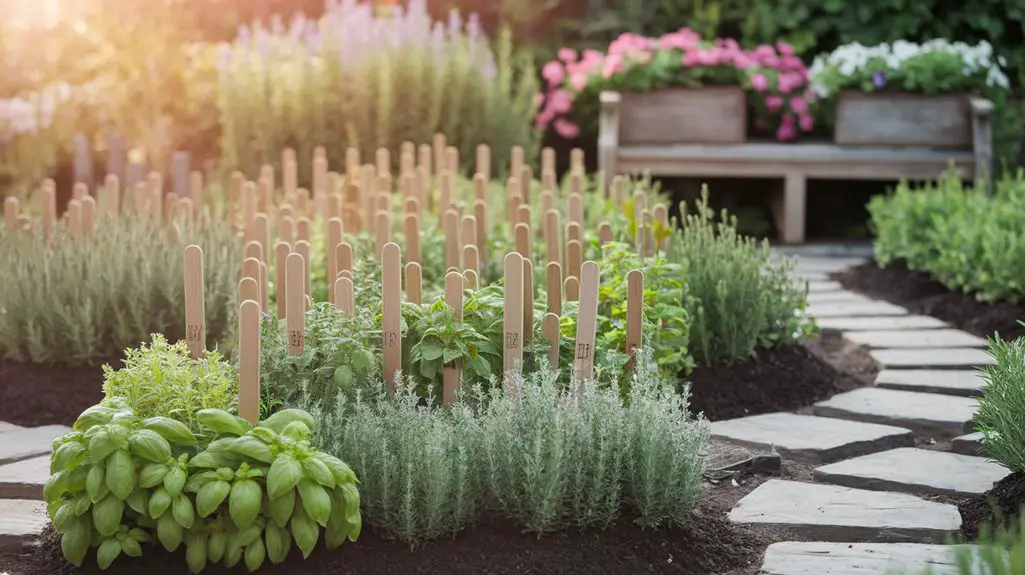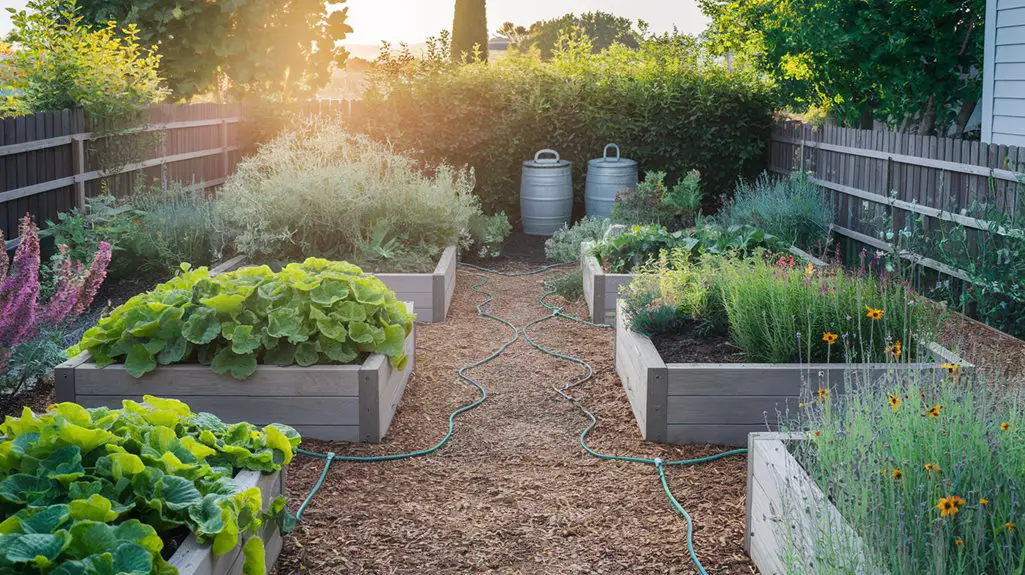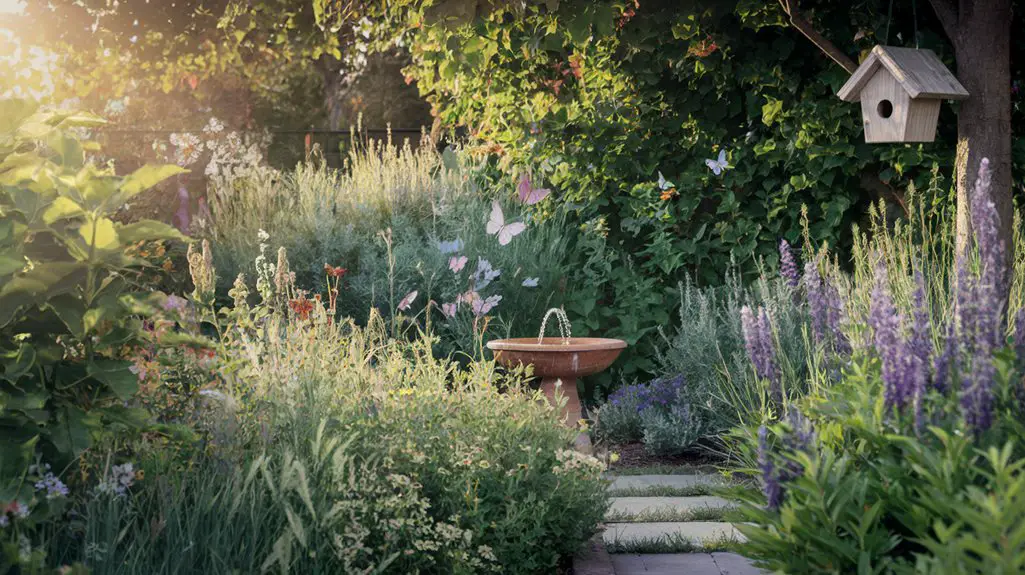When you're ready to organize your family herb garden, you'll need to think about both function and enjoyment. Start by evaluating your available space for maximum sun exposure—most herbs require 6-8 hours daily. You'll want to balance accessibility for little hands with protection for delicate plants. The right organization system transforms a simple herb collection into a thriving family resource that produces year-round. The foundation you establish now determines your garden's productivity for seasons to come.
Choosing the Perfect Location for Your Family Herb Garden
When establishing a family herb garden, selecting an appropriate location constitutes the most critical first step in the cultivation process.
You'll need to identify a spot that receives 6-8 hours of direct sunlight daily, as most culinary herbs require abundant light exposure to develop ideal flavor profiles.
Assess your soil's drainage capabilities; herbs typically thrive in well-draining conditions with pH levels between 6.0 and 7.0.
Consider proximity to your kitchen for convenient harvesting during meal preparation. Protection from strong winds will prevent desiccation and physical damage to delicate plants.
If you're dealing with limited space, vertical gardening solutions or container arrangements can maximize your growing area. Additionally, incorporating year-round herb garden strategies can ensure a continuous supply of fresh flavors throughout the seasons.
Essential Tools and Materials for Herb Garden Organization
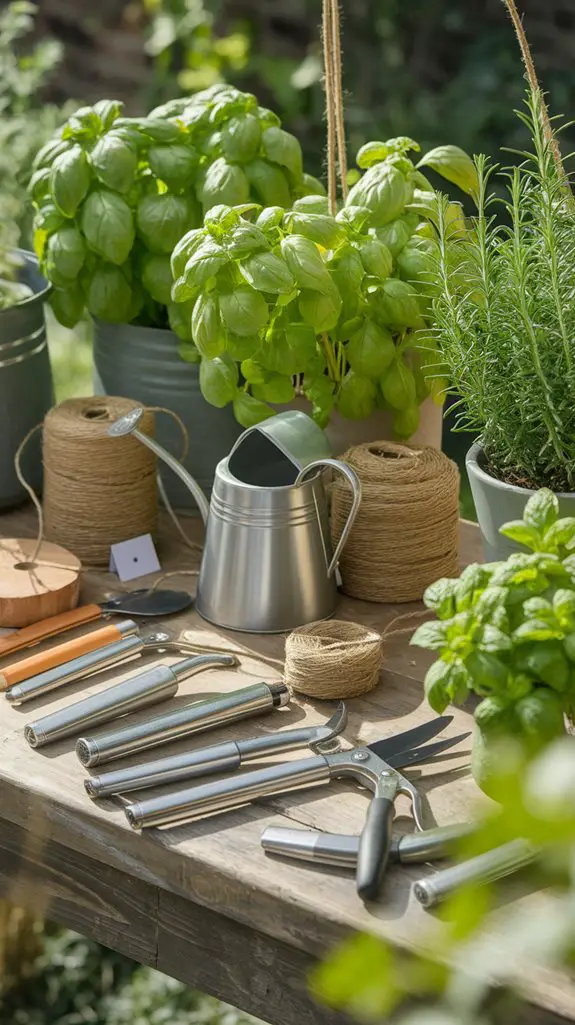
Although establishing a thriving herb garden depends on location, having the right tools and organizational systems will greatly enhance your productivity and enjoyment. Invest in durable pruning shears, trowels, and garden forks specifically designed for precision work in confined spaces. Additionally, incorporating herb garden ideas that attract beneficial insects can create a more balanced ecosystem in your garden.
| Tool Category | Essential Items | Optional Upgrades |
|---|---|---|
| Hand Tools | Bypass pruners, soil knife | Precision snips, dibber |
| Storage | Weather-resistant labels, seed boxes | QR code system, digital inventory |
| Maintenance | Watering can, organic fertilizer | Moisture meter, pH tester |
Implement a methodical labeling system with weatherproof markers and stake labels for accurate plant identification. Consider utilizing transparent storage containers for seeds, allowing visual inventory assessment. You'll need designated spaces for tool storage—wall-mounted racks maximize accessibility while minimizing footprint in your garden workspace.
Kid-Friendly Herb Selection and Layout Planning
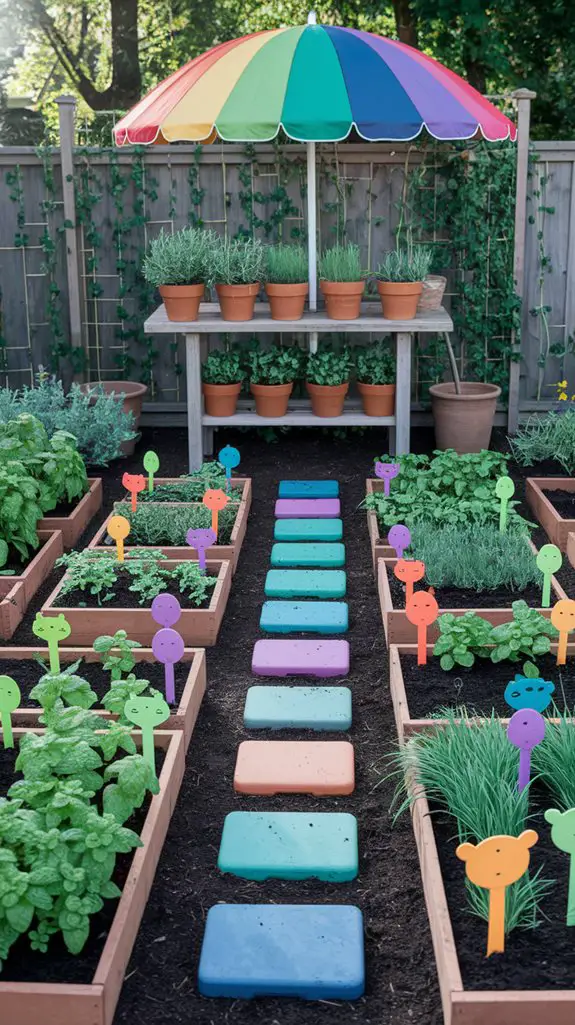
Designing a successful family herb garden requires strategic selection of child-safe herbs and thoughtful layout planning to maximize engagement.
Prioritize non-toxic varieties like mint, basil, lemon balm, and chives—all safe for curious fingers and offering distinct sensory experiences. Allocate dedicated zones using the concept of "reachability," placing child-friendly herbs at lower heights and arranging plants by water requirements.
Consider implementing a color-coding system with different pot colors denoting edible versus decorative herbs. Create wider pathways (minimum 24 inches) between plant sections to accommodate small feet and prevent trampling.
Incorporate small identification stakes with both names and pictures for pre-readers. This systematic approach guarantees safety while cultivating botanical literacy and providing children their own designated garden space. Additionally, integrating engaging herb garden ideas can foster creativity and enhance the educational experience for kids.
Creative Containers and Labeling Systems
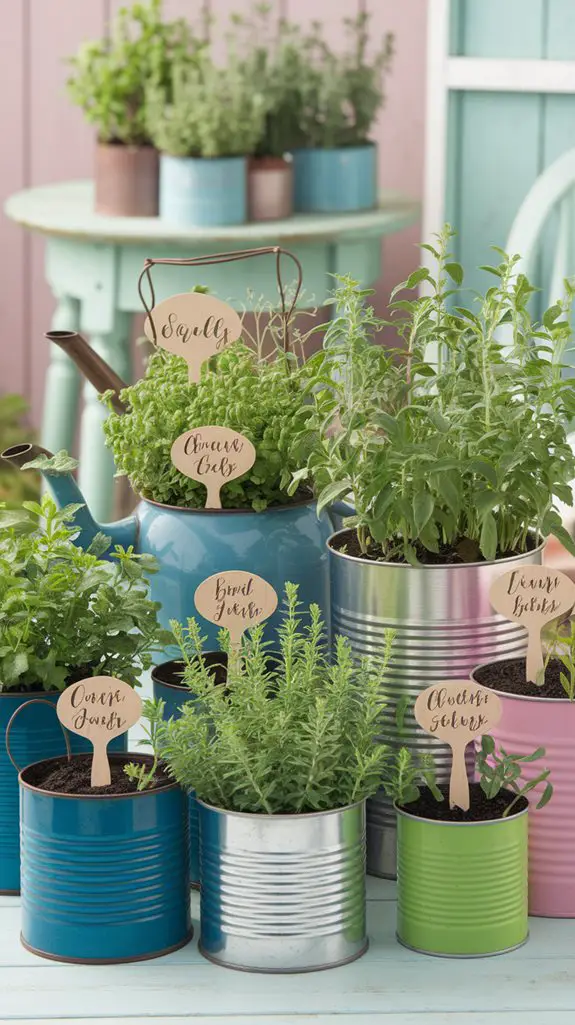
Beyond layout planning, the container selection and labeling approach forms the physical foundation of your family herb garden. Opt for containers with adequate drainage—terracotta pots breathe well while wooden crates offer rustic appeal.
Repurposed items like colanders, tea tins, and mason jars create visual interest while demonstrating sustainability principles to children.
For labeling, implement a consistent, weather-resistant system. Consider these options: painted rocks with herb names, wooden craft sticks dipped in beeswax, laminated cardstock tags, or UV-resistant plastic markers.
Color-code labels to indicate culinary versus medicinal herbs, or group by watering requirements. For young children, incorporate pictograms alongside text labels.
Permanent marker on aluminum tags offers durability, while chalkboard paint allows for seasonal rotation labeling. Always include both common and botanical names for educational value. Additionally, incorporating raised bed herb gardens can maximize your gardening space and enhance accessibility for children.
Seasonal Herb Garden Maintenance Schedule
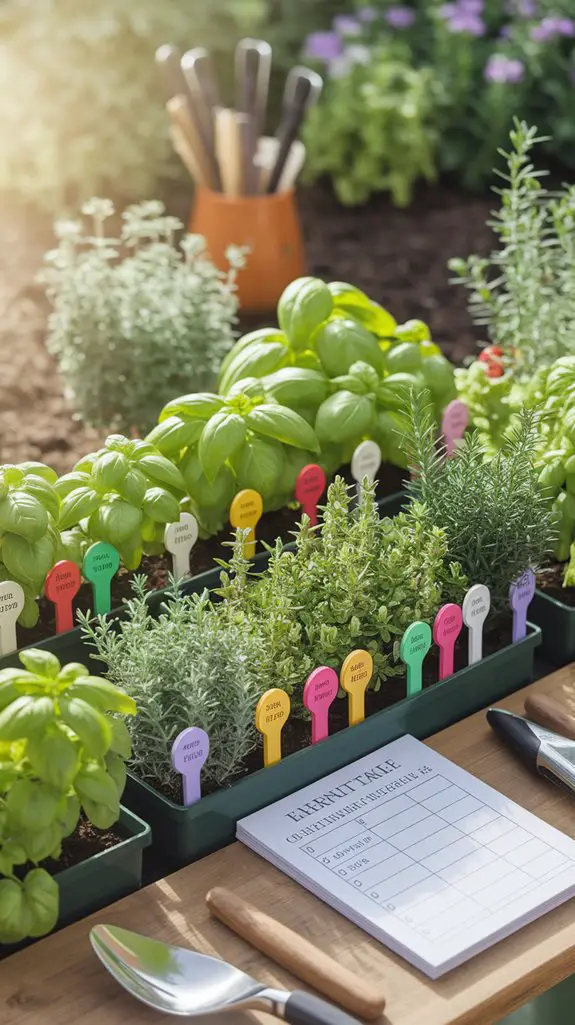
Successful herb gardening requires a structured maintenance routine that changes with the seasons.
Divide your annual maintenance into quarterly tasks to guarantee peak growth and harvest quality.
Spring (March-May): Prune winter damage, divide overgrown perennials, and apply compost.
Begin hardening off seedlings when nighttime temperatures exceed 50°F. Monitor irrigation as soil warms. Consider incorporating culinary-inspired herb garden themes to enhance your gardening experience.
Summer (June-August): Harvest herbs regularly before flowering for maximum flavor concentration.
Water deeply during morning hours to minimize fungal issues. Apply mulch to retain moisture and suppress weeds.
Fall (September-November): Collect seeds from mature plants, transplant tender perennials indoors, and apply protective mulch around roots.
Reduce watering frequency as growth slows.
Winter (December-February): Maintain indoor herbs with grow lights (14 hours daily).
Sterilize tools and plan next season's layout. Order seeds by mid-January.
Harvesting and Preserving Methods as a Family Activity
With your seasonal maintenance plan established, gathering and storing herbs becomes an enriching educational experience for children and adults alike. Schedule harvests in the morning after dew evaporates but before midday heat depletes essential oils.
Assign age-appropriate tasks to maximize engagement while teaching plant biology concepts. Demonstrate proper cutting techniques and explain physiological reasons behind each preservation method. Additionally, incorporating container herb gardening can enhance your family's understanding of plant care and growth.
| Method | Family Activity |
|---|---|
| Drying | Hang bundles from kitchen rafters |
| Freezing | Create herb-infused ice cubes |
| Oil infusion | Monitor solar extraction process |
| Vinegar preservation | Design decorative bottle labels |
| Salt preservation | Measure salt-to-herb ratios |
Document yields and quality variations between harvests using a tracking system. Encourage children to maintain preservation journals with detailed observations. This systematic approach transforms herb preservation from a chore into an applied science lesson.
Expanding Your Herb Garden: Growth and Succession Plans
As your herb garden matures through successive seasons, thoughtful expansion becomes essential for maintaining biodiversity and ensuring continuous harvests.
Implement a rotating planting schedule to prevent soil depletion and reduce pest cycles. Designate three separate zones in your garden, rotating annuals yearly while maintaining perennials in dedicated sections.
Track your garden's performance with detailed cultivation notes, documenting which varieties thrive in specific locations.
Consider vertical expansion using tiered planters or trellises for space-limited environments. Add companion plants strategically—marigolds deter pests while borage attracts pollinators. Additionally, incorporating companion planting techniques can enhance the health and productivity of your herb garden.
For succession planting, sow fast-growing herbs like cilantro and dill every 2-3 weeks during the growing season. This staggered approach maintains a consistent supply and maximizes yield from limited space throughout multiple harvests.
Conclusion
Your family herb garden, like a living laboratory, requires systematic organization to flourish year-round. You've learned to select ideal locations, employ appropriate tools, incorporate child-friendly herbs, and implement creative storage solutions. By following the established maintenance schedule and harvesting protocols, you're ensuring sustainable production. When you're ready to expand, implement succession planting techniques to maximize yield. With these methodical approaches, you'll maintain a productive herb ecosystem that serves both culinary needs and educational purposes.

